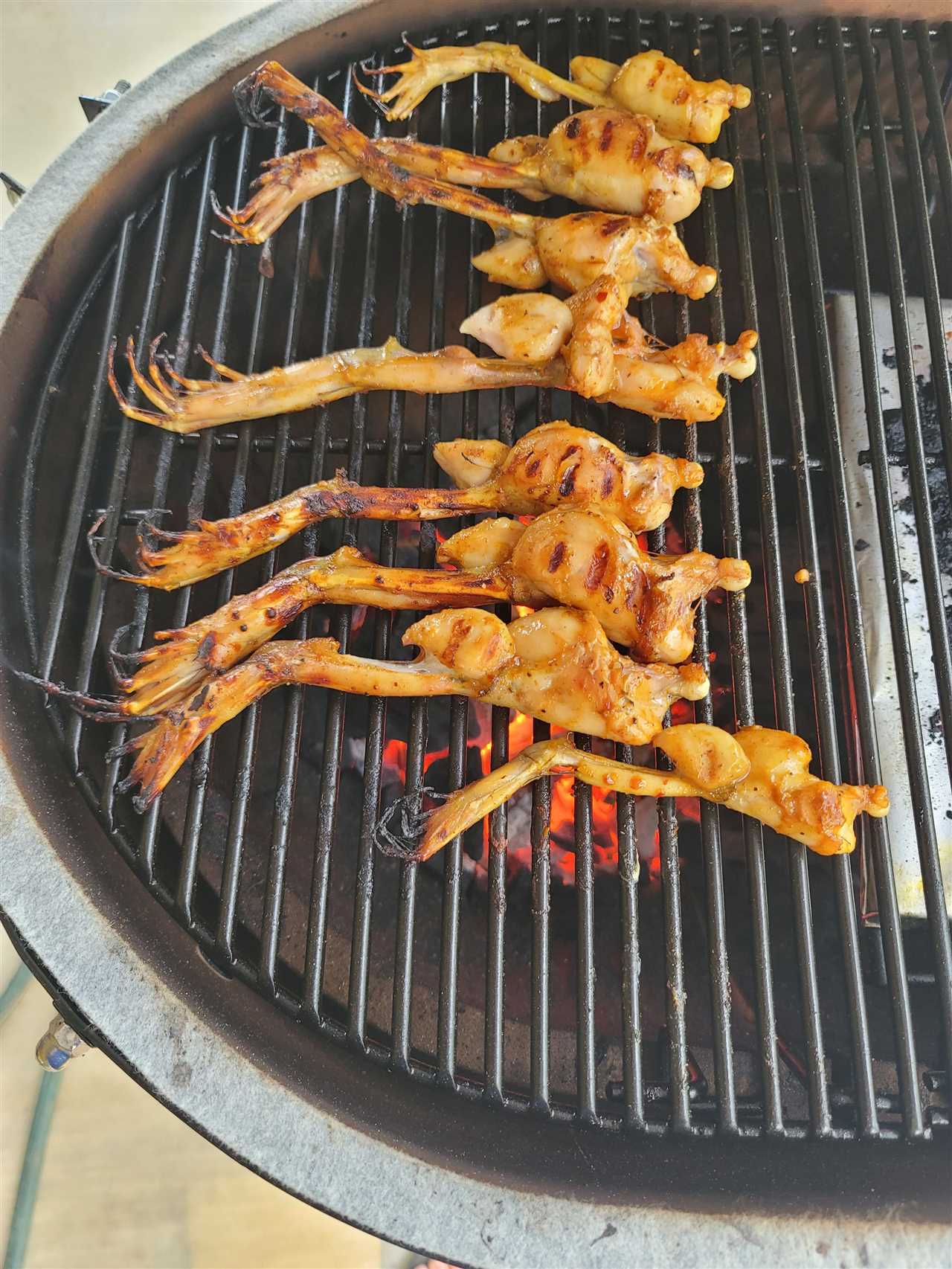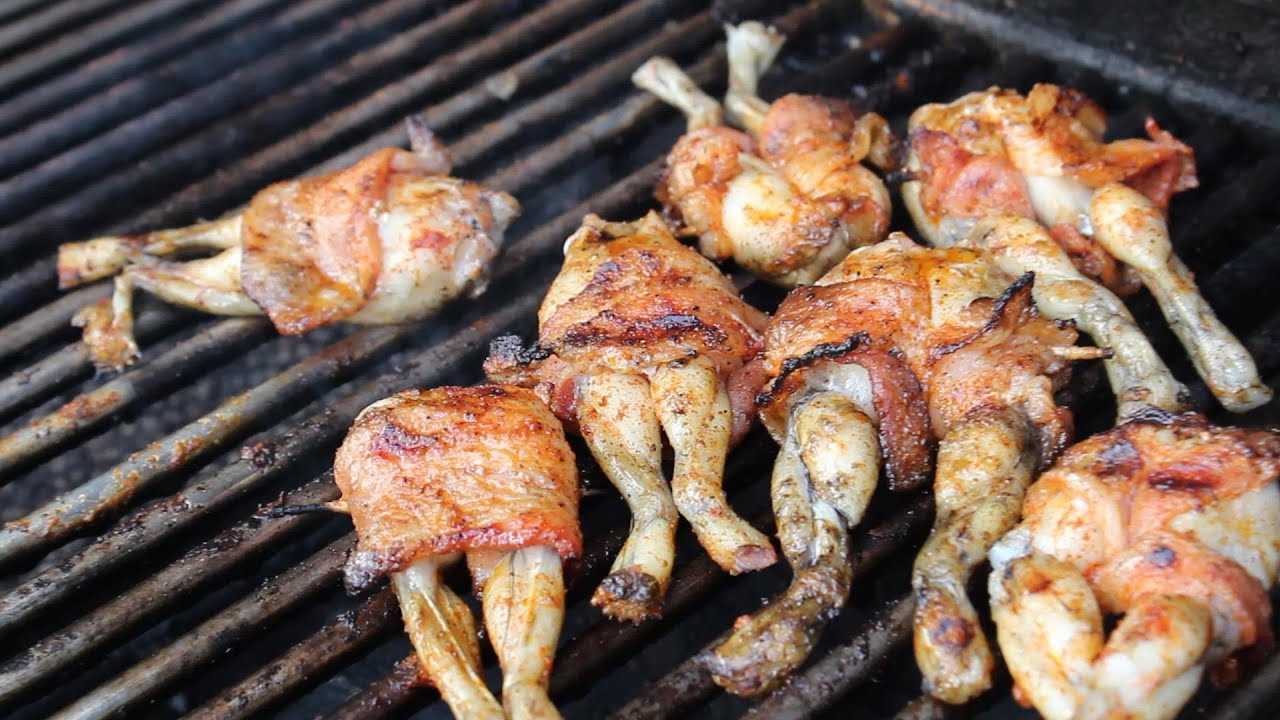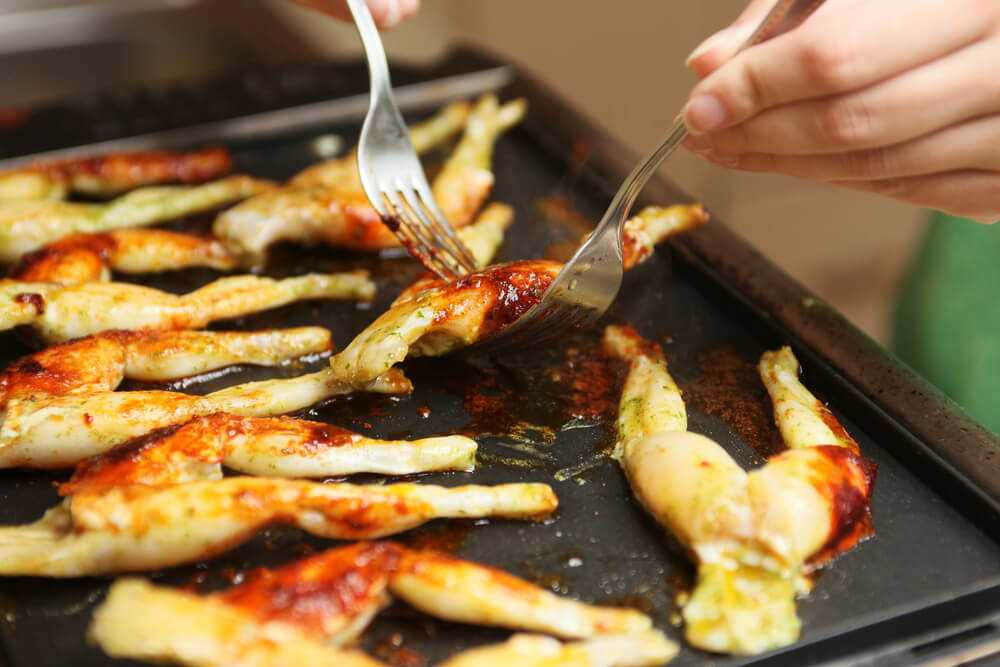
Frog legs are a delicacy that many people may shy away from due to their unique taste and unfamiliarity with cooking them. However, with the right recipe and techniques, you can prepare a delicious and mouthwatering grilled frog legs dish that will leave your taste buds begging for more.
Cooking frog legs on the grill is a fantastic way to bring out their natural flavors and create a crispy and tender texture. To start, you’ll need to season the frog legs with a combination of herbs and spices to enhance their taste. A simple yet effective marinade can be made using ingredients such as garlic, lemon juice, salt, and pepper.
Once the frog legs have been seasoned and marinated, it’s time to fire up the grill. Make sure the grill is preheated to a medium-high heat to ensure even cooking and beautiful grill marks. While grilling the frog legs, brush them with the marinade every few minutes to keep them moist and add an additional layer of flavor.
The key to cooking frog legs perfectly is to grill them until they are golden brown and cooked through, but still tender and juicy on the inside. This typically takes about 8-10 minutes per side, depending on the size of the legs. Remember to keep an eye on them and adjust the cooking time accordingly.
Grilled Frog Legs Recipe: How to Cook Them Perfectly Every Time
To start, make sure you have fresh frog legs that have been properly cleaned. You can find them at specialty seafood markets or even catch your own if you live near a pond or lake. The legs should be plump and firm, with a light pink color.
Before grilling, season the frog legs with a simple combination of salt, pepper, and your choice of herbs and spices. This will enhance the natural flavors and add a hint of seasoning. Some popular choices include garlic powder, thyme, and paprika.
Marinating Frog Legs for Maximum Flavor
For an extra boost of flavor, you can marinate the frog legs before grilling. This will infuse them with additional tastes and tenderize the meat. A classic marinade for frog legs includes olive oil, lemon juice, minced garlic, salt, and pepper. Simply combine these ingredients in a bowl and let the legs marinate for at least 30 minutes to an hour.
While marinating is optional, it is highly recommended for a more flavorful result.
Essential Grilling Tools for Frog Legs
Next, long-handled tongs are necessary to flip and maneuver the frog legs on the grill. This will keep your hands safe from the hot grill and prevent any accidents.
Grilling Techniques for Moist and Tender Frog Legs
While grilling, baste the legs with the marinade or a mixture of melted butter, lemon juice, and herbs for added moisture and flavor.
Remember to add these additional seasonings towards the end of the grilling process to prevent them from burning and becoming bitter in taste.
Tips for Achieving a Crispy Texture on Frog Legs
If you prefer a crispy texture on the outside of your frog legs, there are a few techniques you can try. Firstly, make sure to pat the legs dry before adding any seasoning or marinade. This will help remove any excess moisture and promote a crispy finish.
You can also lightly coat the frog legs in breadcrumbs or flour before grilling, which will create a crispy coating when grilled.
How to Know When Frog Legs are Done
To test the doneness of grilled frog legs, use a meat thermometer to ensure they reach an internal temperature of 165°F (74°C). The meat should be white and firm to the touch.
If you don’t have a meat thermometer, you can also check for doneness by cutting into the thickest part of the leg. The meat should be opaque and pull away from the bone easily.
Serving Suggestions and Delicious Side Dishes
Grilled frog legs are delicious on their own or paired with a variety of side dishes. Some popular options include a fresh green salad, grilled vegetables, or rice pilaf.
You can also serve them with a dipping sauce, such as garlic aioli or a tangy barbecue sauce, to enhance the flavors even more.
Frequently Asked Questions about Grilled Frog Legs

If you have any additional questions about grilling frog legs, here are a few frequently asked questions and answers:
- Q: Can I grill frozen frog legs?
- A: It is best to thaw the frog legs before grilling to ensure even cooking.
- Q: Can I use a gas or charcoal grill?
- A: Both gas and charcoal grills work well for grilling frog legs. Choose the one that you are most comfortable using.
- Q: How long do frog legs need to marinate?
- A: It is recommended to marinate frog legs for at least 30 minutes to an hour for maximum flavor.
With this grilled frog legs recipe and helpful tips, you’ll be able to cook them perfectly every time. Enjoy the unique taste and experience of cooking frog legs on the grill!
Best Ways to Choose Frog Legs for Grilling
- Consider the source: The taste and texture of frog legs can vary depending on the source. If possible, try to find frog legs from a reputable source that specializes in providing high-quality seafood. This will ensure that you are getting the best possible legs for grilling.
- Opt for larger legs: While smaller frog legs can be tasty, larger legs tend to have more meat and can be easier to grill without drying out. Look for legs that are at least 3-4 inches in length for optimal results.
- Ask for recommendations: If you’re unsure about where to buy frog legs or what to look for, don’t be afraid to ask for recommendations. Speak to your local fishmonger or seafood expert who can guide you in the right direction and provide you with the best options available.
By keeping these tips in mind, you can ensure that you choose the best frog legs for grilling. This will result in a delicious and flavorful meal that will impress your guests and leave them craving for more. Happy grilling!
Preparing Frog Legs for the Grill
The first thing you’ll want to do is clean the frog legs thoroughly. Rinse them under cold water to remove any impurities or debris. Make sure to pat them dry with paper towels to remove any excess moisture.
Next, you can choose to remove the skin from the frog legs if desired. Some people prefer to leave the skin on for added flavor and texture, while others prefer to remove it. If you decide to remove the skin, simply use a sharp knife to carefully peel it off.
Once the frog legs are cleaned and prepared, it’s time to marinate them. The marinade will add delicious flavors to the frog legs and help tenderize the meat. There are many marinade recipes available, but a simple and delicious option is to combine olive oil, garlic, lemon juice, salt, and pepper in a bowl. Place the frog legs in a glass dish and pour the marinade over them, making sure they are well coated. Cover the dish with plastic wrap and let the frog legs marinate in the refrigerator for at least 1 hour, or overnight if possible.
Now that the frog legs are properly prepared, they are ready to be grilled to perfection. Follow the grilling techniques mentioned in the article to achieve moist and tender frog legs with a crispy texture. Don’t forget to season them with your favorite seasonings and herbs for added flavor. Serve the grilled frog legs with delicious side dishes for a complete and satisfying meal.
Marinating Frog Legs for Maximum Flavor
Choosing the Right Marinade
Preparing the Legs for Marinating
Before marinating the frog legs, it’s essential to clean them thoroughly. Remove any excess skin or fat and rinse them under cold water to ensure they are free of any dirt or impurities. Pat them dry with paper towels.
Marinating Techniques
If using a ziplock bag, place the cleaned frog legs inside and pour the marinade over them. Seal the bag tightly, making sure to remove any air pockets. Gently massage the bag to ensure that the marinade coats the legs evenly. Place the bag in the refrigerator and let the legs marinate for the desired time.
If using a bowl, place the frog legs in it and pour the marinade over them. Use a fork or tongs to turn the legs in the marinade, making sure they are fully coated. Cover the bowl with plastic wrap and refrigerate for the desired time.
Important Tips

Here are some important tips to keep in mind when marinating frog legs:
- Always marinate the legs in the refrigerator to prevent the growth of bacteria.
- Experiment with different seasonings and flavors to find your favorite marinade.
- Consider adding a dash of oil to the marinade to prevent the legs from sticking to the grill.
Now that you know how to marinate frog legs for maximum flavor, you’re ready to move on to the next step: choosing essential grilling tools.
Essential Grilling Tools for Cooking Frog Legs
Frog Leg Grilling Tools
1. Grilling Basket: A grilling basket is a must-have tool for cooking frog legs on the grill. It allows you to easily flip the legs and prevents them from falling through the grate. Look for a basket with a tight mesh to ensure that the legs stay secure.
2. Tongs: Tongs are essential for handling the frog legs on the grill. They allow you to turn the legs without piercing them, which helps to retain their natural juices and flavors. Opt for a pair of long-handled tongs for easy maneuverability.
3. Basting Brush: A basting brush is useful for applying marinade or seasoning to the frog legs while they are on the grill. Choose a brush with heat-resistant bristles that can withstand high temperatures without melting.
Other Grilling Tools
2. Meat Thermometer: To ensure that the frog legs are cooked to perfection, invest in a meat thermometer. This handy tool will help you determine the internal temperature of the legs and ensure that they are safe to eat.
3. Aluminum Foil: Aluminum foil can be used to create a makeshift grill tray for the frog legs. Simply shape the foil into a tray shape and place the legs on top. This will help prevent them from sticking to the grill and make clean-up a breeze.
| Frog Leg Grilling Tools | Other Grilling Tools |
|---|---|
| Grilling Basket | Grill Brush |
| Tongs | Meat Thermometer |
| Basting Brush | Aluminum Foil |
By having these essential grilling tools on hand, you’ll be well-prepared to cook frog legs to perfection. Whether you’re a seasoned griller or just starting out, these tools will help you achieve a delicious and flavorful result. So fire up the grill and get ready to enjoy the unique taste of grilled frog legs!
How to Preheat the Grill for Frog Legs
Preheating the grill is an important step in cooking delicious frog legs. The right temperature ensures that the legs cook evenly and retain their juicy interior. Here are some tips to help you preheat the grill for perfect frog legs:
1. Clean the grill: Make sure the grill grates are clean and free of any leftover food or debris. This will prevent any unwanted flavors from transferring to the frog legs.
2. Gas grill: If using a gas grill, preheat it by turning all burners on high and closing the lid. Allow the grill to heat up for about 10-15 minutes until it reaches a temperature of around 400-450°F (200-230°C).
3. Charcoal grill: If using a charcoal grill, light the charcoal and let it burn until the coals are covered with a layer of white ash. This usually takes about 20-30 minutes. Spread the hot coals evenly to create a medium-high heat zone.
4. Indirect heat: For frog legs, it’s best to cook them using indirect heat. This means placing them on a cooler part of the grill away from the direct flames. This helps prevent the legs from burning or drying out too quickly.
5. Oil the grill grates: Before placing the frog legs on the grill, lightly oil the grates to prevent them from sticking. Use a basting brush or paper towel dipped in oil to apply a thin layer on the grates.
6. Preheat for 10 minutes: Once the grill is clean, heated, and oiled, close the lid and let it preheat for another 10 minutes. This ensures that the grill is evenly heated and ready for cooking.
7. Check the temperature: Use a grill thermometer to check the temperature of the grill grates. It should read around 350-400°F (175-200°C) for cooking frog legs.
8. Adjust heat as needed: If the grill is too hot, reduce the heat by turning down the burners or spreading the coals further apart. If it’s too cool, increase the heat by turning up the burners or adding more charcoal.
By following these steps to preheat the grill, you’ll be well on your way to cooking delicious and flavorful frog legs. Remember to always monitor the cooking time and temperature to ensure that the legs are cooked to your desired taste. Enjoy!
Grilling Techniques for Moist and Tender Frog Legs
1. Preheat the grill:
Before you start grilling the frog legs, make sure to preheat your grill to medium-high heat. This will ensure that the legs cook evenly and develop a nice grilled char on the outside while remaining juicy and tender on the inside.
2. Season the frog legs:
Seasoning is an essential step in any grilling recipe, and frog legs are no exception. Create a flavorful marinade or rub by combining your favorite herbs, spices, and seasonings. A simple marinade of lemon juice, garlic, salt, and pepper works well to enhance the natural taste of the frog legs.
3. Marinate the frog legs:
Once you have prepared the seasoning mix, gently coat the frog legs in the marinade, making sure to massage it into the meat. Allow the legs to marinate for at least 30 minutes or up to overnight in the refrigerator. This will not only infuse the meat with flavor but also help to tenderize it.
4. Grill the frog legs:
5. Baste with marinade:
While grilling the frog legs, baste them with the leftover marinade every few minutes. This will not only add extra flavor but also help to keep the meat moist and tender.
6. Check for doneness:
The best way to determine if the frog legs are done is by using a meat thermometer. Insert it into the thickest part of the leg and ensure that it reaches an internal temperature of 145°F (63°C). This will guarantee that the meat is cooked through and safe to eat.
7. Let rest before serving:
Once the frog legs are done, remove them from the grill and let them rest for a few minutes. This allows the flavors to settle and the juices to redistribute, resulting in moist and flavorful meat.
By following these grilling techniques, you can ensure that your frog legs turn out moist, tender, and packed with delicious flavors. Serve them with your favorite side dishes and enjoy a unique and tasty meal!
One popular seasoning for grilled frog legs is a simple blend of salt, pepper, and garlic powder. This classic combination adds a savory taste to the meat and enhances its natural flavors. You can also experiment with other herbs and spices such as thyme, rosemary, or paprika to add depth and complexity to the dish.
Once the frog legs are marinated, it’s time to grill them to perfection. Place the legs on a preheated grill over medium-high heat and cook for about 4-6 minutes per side, or until they are golden brown and cooked through. Basting the legs with the marinade during the cooking process will help to keep them moist and flavorful.
| Tips for Seasoning and Grilling Frog Legs: |
|---|
| – Experiment with different seasonings and herbs to find your preferred flavor profile. |
| – Don’t be afraid to get creative with your marinade ingredients. |
| – Remember to generously season the frog legs with salt, pepper, and any other desired spices before marinating. |
| – Be sure to preheat the grill to ensure even cooking and a nice sear on the legs. |
| – Baste the frog legs with the marinade throughout the cooking process to keep them moist and flavorful. |
| – Serve the grilled frog legs hot with your favorite side dishes for a complete and satisfying meal. |
By following these tips and adding your favorite seasonings and herbs, you can take your grilled frog legs to the next level and create a memorable dish that will delight your taste buds.
Tips for Achieving a Crispy Texture on Frog Legs

When grilling frog legs, achieving a crispy texture is key to enhancing their delicious taste. Here are some tips to help you achieve that perfect crunch:
- Use a marinade: Before grilling, marinate the frog legs in a flavorful mixture of your choice. This not only adds moisture but also helps in tenderizing the meat. A simple marinade of olive oil, lemon juice, garlic, and your favorite seasonings, such as salt, pepper, and herbs, can work wonders.
- Pat dry before grilling: Once marinated, make sure to pat the frog legs dry with paper towels. This removes any excess moisture and allows them to grill and crisp up evenly.
- Season right before grilling: Just before placing the frog legs on the grill, season them with additional herbs and spices. This adds an extra layer of flavor and helps create a caramelized crust.
- Preheat the grill: Make sure your grill is preheated to a medium-high heat before adding the frog legs. This ensures a hot cooking surface, which is essential for achieving that desired crispiness.
- Oil the grill grates: To prevent sticking, brush the grill grates with oil before placing the frog legs on them. This also helps in creating those beautiful grill marks.
- Grill over direct heat: Place the frog legs directly over the heat source on the grill. This allows them to cook quickly and develop a crispy exterior.
- Don’t overcrowd the grill: Give each frog leg enough space on the grill so that they can cook evenly. Overcrowding can lead to steaming rather than grilling, resulting in a soggy texture.
- Flip only once: Resist the temptation to constantly flip the frog legs. Let them grill undisturbed for a few minutes on one side before flipping them over. This allows for a nice sear and crispy texture to develop.
- Monitor the internal temperature: Invest in a meat thermometer to ensure that the frog legs reach a safe internal temperature of 160°F (71°C). This guarantees that they are cooked through while remaining juicy on the inside.
- Let them rest: After removing the frog legs from the grill, let them rest for a few minutes before serving. This will allow the juices to redistribute and ensure maximum tenderness.
By following these tips, you’ll be able to achieve perfectly crispy frog legs on the grill, complemented by their delicious taste and the seasoning of your choice. Enjoy this unique and flavorful dish that will impress your friends and family!
How to Know When Frog Legs are Done
Knowing when frog legs are done cooking is crucial to ensure they are tender and flavorful. Here are a few tips to help you determine if your frog legs are cooked to perfection:
- Check the internal temperature: Insert a meat thermometer into the thickest part of the frog leg. The recommended internal temperature for cooked frog legs is 145°F (63°C). If the temperature hasn’t reached this point yet, continue grilling for a few more minutes.
- Observe the color: Fully cooked frog legs will turn white and opaque. If they still appear translucent or pinkish, they need more time on the grill.
- Look for a crisp exterior: Grilling frog legs can result in crispy skin, which adds a delightful texture to each bite. If the skin is still soft, let them grill for a bit longer until it becomes crispy.
- Check for flakiness: Gently press a fork or knife against the flesh of the frog leg. If it easily flakes apart, it is likely cooked through. If it still feels firm or rubbery, it needs more time on the grill.
Serving Suggestions and Delicious Side Dishes for Grilled Frog Legs
Once you have grilled your frog legs to perfection, it’s time to think about what to serve them with. Here are some delicious side dishes and serving suggestions that will complement the taste of the grilled frog legs.
1. Rice Pilaf: A flavorful and aromatic rice pilaf is a great accompaniment to grilled frog legs. The delicate flavors of the marinade and seasoning on the frog legs will pair beautifully with the fragrant rice.
2. Grilled Vegetables: Choose your favorite vegetables, such as zucchini, bell peppers, or asparagus, and grill them alongside the frog legs. The smoky flavors from the grill will enhance the taste of the vegetables and provide a well-rounded meal.
3. Fresh Salad: A refreshing salad with crisp lettuce, cherry tomatoes, cucumber, and a tangy vinaigrette is a great way to balance out the richness of the grilled frog legs. The fresh flavors and crunchiness of the salad will complement the tender meat.
4. Garlic Mashed Potatoes: Creamy and garlicky mashed potatoes are a classic side dish that goes well with almost any grilled meat. The smooth texture and savory flavors will complement the taste of the frog legs.
5. Crusty Bread: Serve some crusty bread on the side to soak up the delicious juices and marinade from the grilled frog legs. It’s a simple yet satisfying accompaniment that will enhance the overall dining experience.
6. Citrus Salsa: Prepare a zesty citrus salsa with a combination of oranges, grapefruits, lime juice, red onion, and cilantro. The bright flavors and acidity of the salsa will cut through the richness of the frog legs and add a burst of freshness.
With these delicious side dishes and serving suggestions, you can create a well-balanced and satisfying meal centered around the grilled frog legs. The combination of flavors and textures will take your taste buds on a tantalizing journey.
Frequently Asked Questions about Grilled Frog Legs
Are frog legs a popular dish?
Frog legs are considered a delicacy in many cultures and are enjoyed by people all over the world. They have a unique taste and texture that make them a delicious and sought-after dish.
What is the best recipe for cooking frog legs?
There are many different recipes for cooking frog legs, but one popular method is grilling. Grilling frog legs gives them a smoky flavor and a crispy texture that pairs perfectly with the tender meat. It is a simple and delicious way to cook frog legs.
Do frog legs need to be marinated before grilling?
Marinating the frog legs before grilling is not necessary, but it can enhance the flavor. A simple marinade of oil, lemon juice, garlic, and herbs can infuse the meat with delicious flavors. The marinade can be applied for at least 30 minutes before grilling to allow the flavors to penetrate the meat.
What seasonings work well with grilled frog legs?
Frog legs have a mild flavor and can be enhanced with various seasonings. Some popular options include garlic, lemon, thyme, rosemary, and cayenne pepper. These seasonings add depth and complexity to the taste of the frog legs.
Can frog legs be grilled on any type of grill?
Yes, frog legs can be grilled on any type of grill, including charcoal, gas, or electric. The important thing is to preheat the grill to medium-high heat before cooking the frog legs to ensure even cooking and a crispy exterior.
How do I know when the frog legs are done?
The frog legs are done when the meat is opaque and firm, and the internal temperature reaches 145 degrees Fahrenheit (63 degrees Celsius). Cooking times may vary depending on the size of the frog legs and the heat of the grill, so it is best to use a meat thermometer to ensure they are cooked properly.
What are some delicious side dishes to serve with grilled frog legs?
Grilled frog legs can be served with a variety of delicious side dishes. Some popular options include roasted potatoes, steamed vegetables, cornbread, rice pilaf, or a fresh salad. These side dishes complement the flavors of the frog legs and complete the meal.
Are grilled frog legs safe to eat?

I’m Lena Adams—a product of an unconventional upbringing in the African wilderness. My father, a daring explorer of African wildlife, sparked my fascination with reptiles, a passion that intertwined with the tragic loss of my mother during an expedition, leaving an indelible mark on my life. Driven to understand the creatures that captivated my parents, I embarked on my journey, sharing insights about reptiles, frogs, and lizards on my website. Through my explorations and conservation efforts, I honour my family’s legacy while seeking connections—to the creatures, nature, and the mother whose presence I yearn to understand.

